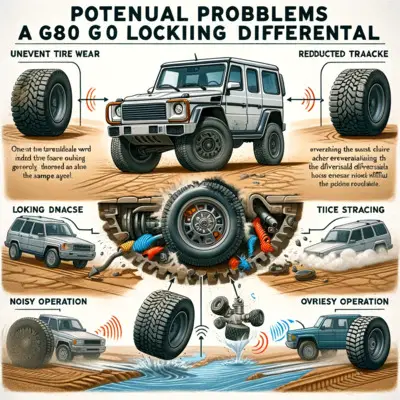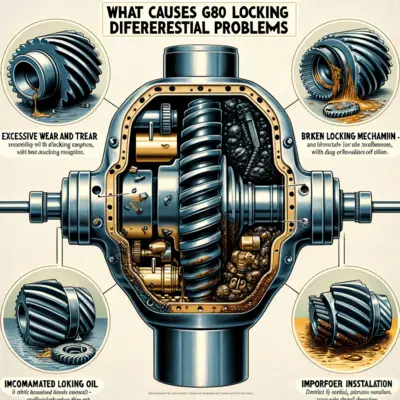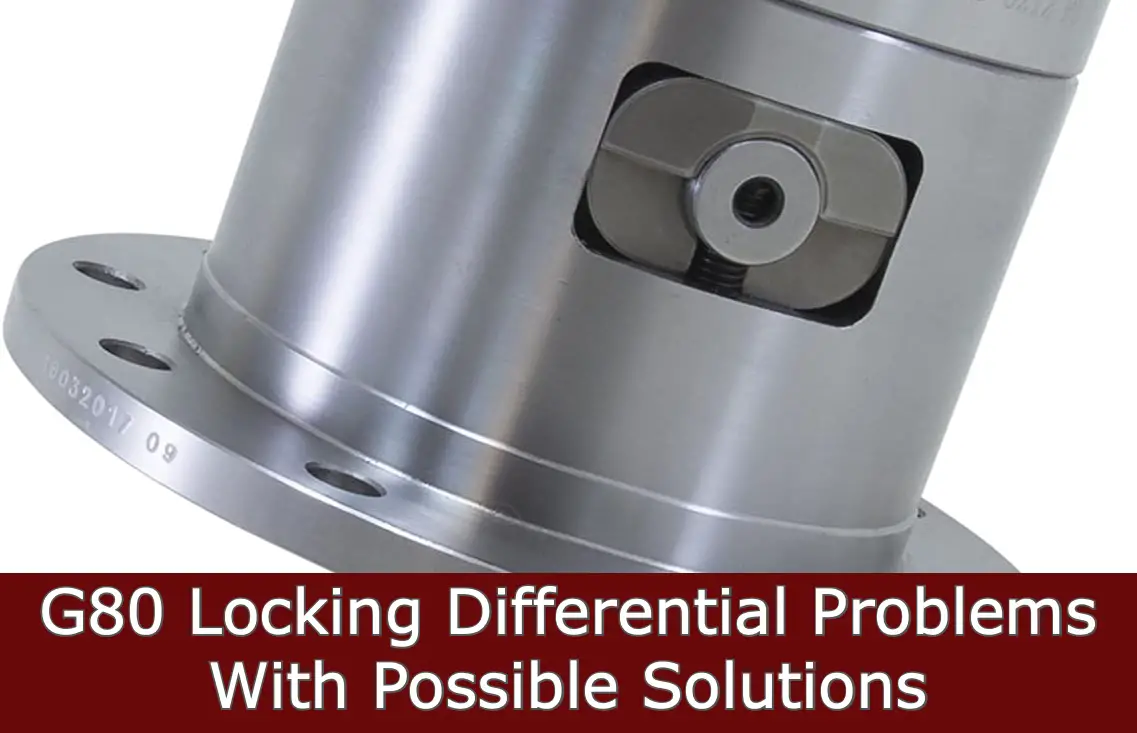When towing, carrying a load, or just exploring roads, it’s always vital to have good vehicle traction. For those who own a pickup, warp-speed wheel rotation may mean that that’s as far as you get. At a minimum, you must add some sort of smart technology to your axles for controlling your inner brakes.
In that case, the G80 locking differential remains at the top of the list. This outstanding locking differential has earned immense popularity among 4WD drivers across the world. However, there are some users who have reported G80 locking differential problems.
Gradually these seem to be common among others as well. Maybe that’s the reason that brings you here, right? Well, here we’ll get to know some common issues regarding G80 locking differential and possible solutions as well.
Potential G80 Locking Differential Problems

Even though different users have reported several issues regarding the G80 locking differential, we’re going to discuss the three most common issues. These are:
Lack of Response in Locking And Unlocking
The coaxial air-locks built into the G80 system are effective at working together with the tires to make certain they are securely locked when you’re driving on an unacceptable surface.
The flywheels in the mechanism are engaged to remove the lock when appropriate. Locking happens when you’re traveling at low levels, and unlocking most often happens when surpassing twenty miles per hour.
The system does not trigger the locks until your car stops while watching out for inclinations and slippery areas. However, the tires maintain that differential speed no matter how you twist and turn and are diagnosed with the G80 locking differential problem as a result.
Uncontrolled Spinning
The G80 lock differential issue begins as soon as you start your automobile and leave a garage or parking lot. It will immediately become active once you are through a single turn or exit from the parking lot.
The automobile must have a secure and progressive relationship among the back wheels to maintain traction. This ensures there is no speed at which the back wheels will not remain rolling on the road.
That particular tire will immediately begin rotating at a high speed and fry. In rear-wheel-drive settings, this can affect the journey by lowering the traction that is necessary.
Likewise, the tire will gradually slow to a halt, but remounting it is not frequently done. Your car might also shed its trustworthiness because of the consistent spinning, spilling your anti-lock braking system.
If your vehicle involves roads that are a bit slippery, then you could unintentionally lose control of your car. In some cases, both your wheels could start spinning at the same time. It’s a dangerous situation and can cause accidents.
Persistent Noise
Another G-80 locking differential trouble attributed is the possibility of engine failure due to sound leakage or engine oil problems. You can hear the muffled noise from the lock unit beneath your car.
You may also see oil or a thick, contaminated liquid dripping from the chamber. Generally, this liquid has a medium consistency with a yellowish color.
The noise is not very loud, and you might need to be closer to the source of the sound to hear it. These factors may change the operation of the locking and unlocking mechanisms, which makes the system operate inadequately, and you may even experience other interrelated G80 locking differential troubles.
What Causes G80 Locking Differential Problems?

Now, you are probably contemplating the root cause of your G80 locking differential problems. Let’s pay closer attention to it.
Fluid Contamination
A G80 locking system may or may not use a lubricant that could help reduce the friction that may occur inside it. Such lubricants may not be required, or the lock unit may or not have them. However, lubricants can also harm the mechanism, and they can cause changes to the metal structure.
Hence, it could eventually start to disintegrate and become damaged. The leaking fluid may trigger the locking differential challenges with the vehicle’s G80. The fluid can also start leaking through the vehicle’s unit cover and trigger the G80 issues with the automobile.
Mechanical Damage
The G80 lock system has a mechanism called a flywheel connected to a governor. It activates the lock system of the G80 car, and it also alerts the flywheel when the wheel shaft locks or unlocks. This system keeps the wheels from spinning in place, so the car is balanced at speed.
Hence, it’s apparent that the entire system works on the devices’ metal parts. In the event that these damages occur, the G80 locking differentials eventually become dysfunctional. As a result, the parts of the components may experience damage. Sometimes, these parts eventually fall off as a result of wear or tear. Wear or tear usually occurs to the engine.
The other pieces of gear inside the lock parts have rotating components that have to be ready to rotate in order for the lock components to operate at their most efficiently. The broken sections of these gears or other apparatus constitute a barrier to the machinery required to lock and unlock the wheels.
To function at peak effectiveness, the gears needed for the rotation of the flywheel must stay undamaged. Gears that are dysfunctional or out of order can make it harder for the gear governor to send the codes required to the G80 locking differential.
Possible Solutions to G80 Locking Differential Problems
Now it’s time to look at possible solutions to overcome those issues with your G80 locking differential. Here are they:
Change The Lubricant
Using an inert fluid that does not change the layout may help you avoid the G80 locking differential problems. Keep in mind that you can not use chemicals in the system.
Being aware of the gasket along with utilizing a silicone coating can help protect your differential and prevent it from wear. Thoroughly scrub the hopper and clean the cover, removing any contaminated fluid. Afterward, you must add fresh oil.
Replace The Parts
Often, G80 locking differential problems occur because a malfunction in the system has been detected. Best to check inside to pinpoint the culprit. You can remove the top of the device and view every bit of it.
You can check each part for the damaged ones and then determine if these damaged pieces led to the problems. Typically, the part responsible for crowning the vehicle is the thing that’s kept from the lowest and most important place. A pinion is the sole thing you disassemble through the middle by removing the screw.
Once that’s taken apart, you can proceed to access the overall system. After inspecting the pinion, you must further assess its condition as well. When you choose replacement parts, you do not have to fear them falling apart due to normal operating conditions. You can use typical fasteners to secure them.
If you’re not acquainted with where to repair a malfunctioning part of the locking system, you can increase the speed of the tires. Use a camera close to the device to evaluate the functioning of all the parts, record how they are working, and document any problems or faults.
FAQ
How do I know if my G80 locker is working?
If you are experiencing a loss of traction in your differential, it is likely that your G80 locking differential is not working. To test your G80 locking differential, place the car in a 4-wheel drive low and drive around a small corner. If you experience a loss of traction, your G80 locking differential is likely not working and should be replaced.
How does the G80 locking differential work?
The G80 locking differential is a mechanical differential that uses a ring and pinion gear to transfer power from the rear axle to the front axle. It allows the vehicle to rotate faster around the longitudinal axis than the front axle can rotate. This helps the vehicle maintain its balance and prevents it from skidding.
How do identify the G80 Locking differential issues?
There are a few things you can do to check if your G80 Locking differential is experiencing issues. First, take a look at the fluid levels in both the differential and the transfer case. If there is too much or too little fluid in either of these areas, it could be an indication that the differential is not functioning properly. Additionally, you can try to move the vehicle around to see if there is any abnormal noise or vibration associated with the differential.
How does a G80 disengage?
The G80 locking differential disengages by rotating the differential pinion shafts out of engagement with the gear teeth on the axle. This is done by releasing a set of spring-loaded pins that hold the differential in place.
Final Words
We’re most likely to experience growth in our ability to solve issues once we truly understand the reason that precisely leads to error. If you have already interacted with the G80 Locking Differential Problems, this could be an indication you have a decent grasp of the problem itself. When you’re conscious of what can happen as a result of a particular case, it’s possible to start thinking about the measures that can be taken. As a result, you will not need to find professional medical care in most cases.
